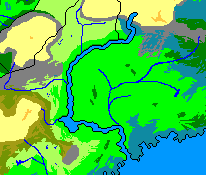Egale River

The Egale River is the longest river and chief river of the largest drainage basin on Tapfer. From its source of Lake El in the Talon Mountains in Egale and Thalassa it flows generally south for 1,490 miles (2400 km) to the Egale River Delta in the Bight of Tapfer. With its main tributaries its watershed drains parts of three demesnes in Eastern Natopia and three regions in Western Natopia. The river served as the natural boundary for Natopia on Tapfer from 1520 to 1651. It was an important symbol of cooperation between Natopia and its long-time neighbor Alexandria. The river now forms the border between Eastern Natopia and Western Natopia, but from 1651 to 1709 it was entirely within Natopia.
Lake Egale (sometimes Lake Loredo) is a naturally occurring lake along the river. It was considered the source of the river until Anthelia surveyed the upper section in 1508 AN. The Micras Cartography Society accepted the Anthelian survey and amended the society's maps in 1520. The lake itself was formed by natural dams located south of modern-day St. Bartholoma.
Significance
The river provides transportation, energy, and fertile soil. It is considered a critical area of cultural and economic importance.
Energy
Geologists estimated that the lake was formed only a few hundred years ago by earthquakes and landslides and that the lake would eventually erode the dams and flood the lower Egale valley, causing massive destruction to the fertile farmlands downriver. In the 1550s, a hydroelectric dam was built at St. Bartholoma by the Egale Valley Authority--a former division of Alex-Nat Corporation, now an independent public utility--to provide cheaper and more sustainable electricity for Natopians and Alexandrians in central Tapfer. This relieved dependence on the natural gas deposits in the Talon Mountains.
Agriculture
Nearly half all all non-grain and non-fruit foodstuffs produced in Tapfer are grown or raised along the Egale river or its tributaries. Mehlville's location at the mouth of the river has caused it to grow into one of Eastern Natopia's largest cities.
Symbolism
The Egale River has always been seen as the western boundary of Natopia. It is often paired with Borders Bay when discussing the critical waterways and natural boundaries of Natopia. The Fountain of the Waters, located in the capital city, is a monument dedicated to the importance of the Egale River. It also represented the spirit of industry, cooperation, and friendship with Alexandria, who occupied the western bank of the river for generations. It has been a convenient way to divide Tapfer into eastern and western spheres of interest. Its status as a boundary meant that it was the only natural point of division considered during the Division of the Natopian Empire. The demesnes of Egale in Eastern Natopia and Transegale in Western Natopia are both named after the river.
Divisions
The Egale River can be divided into three sections: the Upper Egale, from its source to the Lake Egale Dam; the Middle Egale, between the dam and the confluence with the Anthelia River; and the Lower Egale, which flows from the Anthelia River to the Bight of Tapfer.
Upper Egale
The Upper Egale has three major tributaries: the Nova River, the Massat River, and Nerthus River. It has many important ports along its course including Elham, Vastra, Beit-Zakyyria, St. Bartholoma, and Nerthus. Important crossings are at Elham, Vastra, Beit-Zakyyria, and St. Bartholoma. It is important economically as it carries iron and agricultural products.
Middle Egale
The Middle Egale is a relatively short stretch of the river between St Bartholoma and Holstein. There are no major tributaries, cities, or crossings along this section. Local cross-river traffic is handled by ferry service.
Lower Egale
The Lower Egale has one major tributary, the Anthelia River, which flows into the Egale north of Holstein. The Anthelia River flows from its source near Frieden Mine, Northern Klaasiya, and has several tributaries of its own. The Anthelia river and Egale river embayments provides incredibly fertile soil, producing half of the continent's general agriculture output. River traffic south of Holtstein is the second-busiest river in the southern hemisphere with crops, rare minerals, and raw iron being transported to Mehlville for export and processing. Major cities along the river are Holstein and Mehlville, and there are important crossings at each city. The Port of Mehlville is one of the busiest ports in Eastern Natopia, and among the busiest in the southern hemisphere.